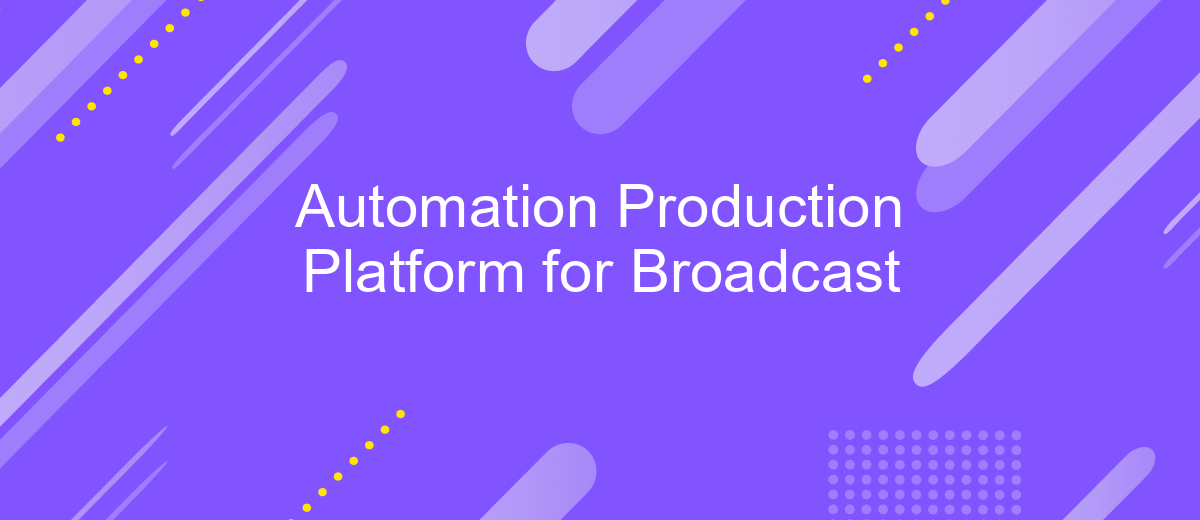Automation Production Platform for Broadcast
In the rapidly evolving world of broadcast media, the need for efficiency and precision has never been greater. An Automation Production Platform for Broadcast streamlines workflows, enhances content delivery, and reduces human error. By integrating cutting-edge technology, broadcasters can now focus on creativity and storytelling, while the platform handles the complexities of production, ensuring seamless and high-quality broadcasts every time.
Introduction
The advent of automation in broadcast production has revolutionized the industry, offering unprecedented efficiency and precision. As media consumption continues to evolve, broadcasters are under increasing pressure to deliver high-quality content swiftly and reliably. Automation production platforms are at the forefront of this transformation, enabling seamless integration of various production elements and reducing the need for manual intervention.
- Improved operational efficiency by automating repetitive tasks
- Enhanced content quality through consistent production processes
- Cost savings by reducing labor and resource requirements
- Increased flexibility to adapt to changing content demands
These platforms not only streamline workflows but also empower broadcasters to focus on creativity and storytelling. By leveraging advanced technologies such as artificial intelligence and machine learning, automation production platforms can optimize resource allocation and minimize errors. As the broadcast industry continues to embrace these innovations, the potential for enhanced viewer experiences and operational excellence becomes increasingly attainable, paving the way for a new era in media production.
Benefits of Automation in Broadcast Production

Automation in broadcast production offers numerous advantages, significantly enhancing efficiency and productivity. By streamlining workflows, automation reduces the time and effort required for repetitive tasks, allowing creative teams to focus on content creation and storytelling. Automated systems ensure consistency in broadcasting, minimizing human errors and maintaining high-quality standards across all productions. This leads to a more seamless viewer experience, as content is delivered accurately and on time.
Moreover, automation enables better resource management by optimizing the use of equipment and personnel, reducing operational costs. Integration platforms like ApiX-Drive facilitate seamless connectivity between various tools and services, further enhancing the automation process. These integrations allow for real-time data exchange and synchronization, ensuring that all systems work harmoniously. As a result, broadcasters can respond swiftly to changes and demands, maintaining a competitive edge in the rapidly evolving media landscape. Overall, automation in broadcast production not only boosts efficiency but also empowers teams to innovate and deliver exceptional content consistently.
Key Features of an Automation Production Platform

An Automation Production Platform for broadcast is a transformative tool designed to streamline and enhance the efficiency of broadcasting operations. By integrating various technologies, it offers broadcasters the ability to automate repetitive tasks, reduce human error, and ensure consistent output quality.
- Scalability: The platform easily adapts to growing production needs, accommodating additional channels and increased content volume without compromising performance.
- Real-time Monitoring: Provides comprehensive analytics and monitoring tools to track performance metrics and ensure seamless operation.
- Customizable Workflows: Users can tailor workflows to meet specific production requirements, enhancing flexibility and control over content delivery.
- Integration Capabilities: Seamlessly integrates with existing broadcast systems and third-party applications, facilitating a cohesive production environment.
- Advanced Scheduling: Offers sophisticated scheduling features that automate content playback, reducing manual intervention and optimizing resource allocation.
By leveraging these key features, broadcasters can significantly enhance their operational efficiency and focus on delivering high-quality content. The platform's ability to integrate with existing systems and its customizable nature make it an invaluable asset in the fast-paced world of broadcasting, ensuring that broadcasters remain competitive and responsive to audience demands.
Implementation and Integration

The implementation of an Automation Production Platform for Broadcast involves a strategic approach to seamlessly integrate advanced technologies into existing workflows. Initially, a comprehensive analysis of current operations is conducted to identify areas where automation can enhance efficiency and accuracy. This phase is crucial for tailoring the platform to meet specific broadcast requirements.
Once the analysis is complete, the integration process begins by deploying the platform's core components. This involves configuring the software to align with the broadcast infrastructure, ensuring compatibility and minimal disruption to ongoing operations. During this phase, collaboration with IT and broadcast engineering teams is essential to address any technical challenges.
- Conduct thorough system testing to ensure all automated processes function as expected.
- Train staff on new tools and workflows to maximize the platform's potential.
- Establish a feedback loop for continuous improvement and adaptation.
Post-implementation, ongoing monitoring and support are vital to maintain optimal performance. Regular updates and system evaluations ensure the platform evolves with technological advancements and changing broadcast needs. This proactive approach guarantees the platform remains a valuable asset in the dynamic broadcast environment.


Future Trends and Innovations
The future of automation production platforms in broadcasting is set to be revolutionized by the integration of artificial intelligence and machine learning technologies. These advancements will enable more efficient content creation and distribution processes, allowing broadcasters to personalize and target their content more effectively. As AI continues to evolve, we can expect automation systems to become more intuitive, reducing the need for human intervention and enabling a seamless production workflow.
Moreover, the integration of cloud-based solutions will further enhance the capabilities of automation platforms. Services like ApiX-Drive will play a crucial role in streamlining these processes by offering seamless integration of various applications and services. This will allow broadcasters to automate data transfers and synchronize tasks across different platforms effortlessly. As a result, the industry will see a significant reduction in operational costs and an increase in flexibility, paving the way for innovative content delivery methods and enhanced viewer experiences.
FAQ
What is an Automation Production Platform for Broadcast?
How can automation improve broadcast production?
What are the key features to look for in a broadcast automation platform?
How do I integrate existing systems with an automation platform?
What challenges might I face when implementing a broadcast automation platform?
Apix-Drive will help optimize business processes, save you from a lot of routine tasks and unnecessary costs for automation, attracting additional specialists. Try setting up a free test connection with ApiX-Drive and see for yourself. Now you have to think about where to invest the freed time and money!

